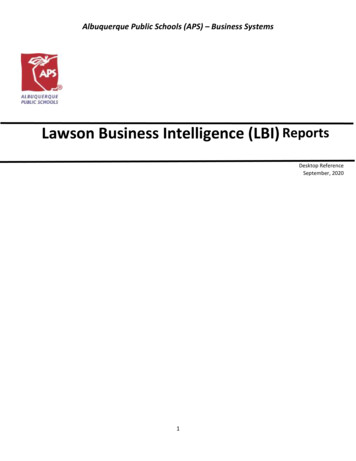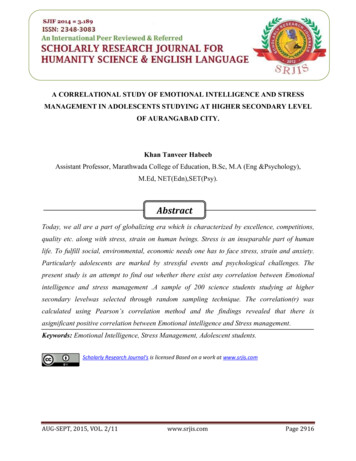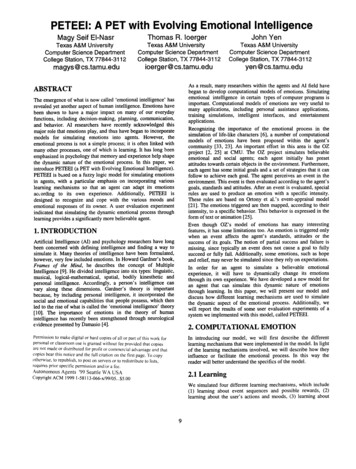
Transcription
Intelligence ReportWelcometo theAge of theArt Industry(The Art World Is Over)Why AuctionGuarantees HaveLost Their LusterForward-ThinkingCollectors on WhatThey Buy & WhyWhat You Needto Know About theAfrican ContemporaryArt Market
IntroductionWhen artnet launched the artnet Magazine in 1995, it was only the secondonline publication in the world (after Slate, which was later bought by Microsoft).Our company had just become one of the internet’s first commercial users—butit had already defined the products and services that we more or less continue tooffer today, all of which seek to level the playing field for galleries and collectors.In the ensuing decades, the art world has transformed, with a ballooningnumber of artists and a market that has become truly global. Meanwhile,the tenets on which artnet was founded—to offer guidance and transparency—are needed more than ever. It is no wonder that artnet’s resolve to considerart quantitatively as well as qualitatively, which 30 years ago was consideredunacceptable, is no longer controversial at all.Over time, the art market has come to understand that the artnet PriceDatabase benefits everyone, because a market can truly only grow if thereis enough credible information easily available to measure its performance.And grow it has: Total worldwide auction sales in 2018 were 19.4 billion,compared to 3.3 billion in 1989, an increase of almost 500 percent. Thetotal size of the art market, including gallery and online sales, is estimatedto be worth over 60 billion today.The art market is far from perfect. Why are certain artists who make exceptional work not showing up meaningfully in these statistics? Has the money thathas been flowing into the market so confused us that we now see price asthe main determinant of quality? Or are we observing just a temporary splittingof the field into various segments that need to be considered and evaluatedseparately? For the moment, the relentless attention the mainstream press paysto high prices has given the financial side of art collecting the lead in our collective understanding of events. But that can change. If we have learned anythingover the past 30 years, it is to expect surprises.Sincerely,Jacob Pabst, CEO1
Editors’ LetterTable of Contents4MarketplaceAs you might glean from the cover, this report advances a thesis: that over the past Total auction sales around the globe30 years, the art world has evolved into an art industry. Once the modestly sized Why the top of the market is shrinkingprovince of connoisseurs, passion-driven dealers, and hobbyist collectors, the art Expert predictions for what’s aheadbusiness today exists as an interconnected global network dominated by multibillion-dollar corporations and swashbuckling, profit-minded investors who careabout numbers as much, if not more, than they care about the art itself.From one point of view, this market is a strange, chimerical amalgam of theluxury industry, the financial sector, and a high-class casino; seen another way, itis a burgeoning engine of creativity and innovation that could yield a new Renais-6What I’m Buying& Whysance in art. As with art itself, the art market’s nature is in the eye of the beholder.Collectors dish on their latestIn this issue, we speak to a trio of collectors who touch on how the business side ofobsessions and the works that got awaythings has changed over the past three decades—for better and for worse.We also dive deep into reams of data, which show that the market is nowslowing, with key indices coming down from their recent peaks. This reportoutlines those areas of retrenchment in the marketplace and identifies where thealarm bells are ringing. It also shows where opportunities are developing, boththrough the data and via an in-depth survey of the increasingly exciting market forAfrican contemporary art. As the current reshuffling continues, it is likely that thewinners and losers with be spread unevenly around the globe, in ways that mirrorAndrew GoldsteinEditor-in-Chiefartnet News@AndrwGoldsteinbroader macroeconomic trends.Because this fall is artnet’s 30th anniversary, our report also takes a look athow the company’s pioneering Price Database shaped the art field and helped accelerate its headlong growth. We spoke to Hans Neuendorf, the founder of artnet,about the obstacles he and the company overcame as it became the first-ever artbusiness to go online—and about his ambivalence regarding the impact that accessto transparent pricing has had on the field he entered as an idealistic art dealer inthe 1960s.Today, 30 years into the history of artnet, and now in the midst of what lookslike the beginnings of a market correction, it is clear that we remain in the infancyof the art industry—with all the positive and negative connotations that word,which conjures a smoke-belching factory, conveys. Where will things go? See youin 30 years.Julia HalperinExecutive Editorartnet News@juliahalperin214The Best-Seller ListsThe top 10 lots of 2019 to date in everymajor category38Why the Golden Age ofAuction Guarantees IsProbably Over80How Hans NeuendorfChanged the ArtBusinessby Eileen Kinsellaby Andrew GoldsteinThese lucrative hedges were once theartnet’s founder recalls how hefinancial instrument of choice fordeveloped the first online auctionspeculators and market manipulators,database and reveals why he isbut now they’ve lost their lustertorn about the sweeping changesit wrought46Collecting Isn’tWhat It Used to Be:A Roundtableby Cristina RuizDimitri Daskalopoulos, Paul Ettlinger,26How the Art WorldBecame (Sniff)the Art IndustryWe pull together exclusive data aboutdiscuss how the business of collectingthe market’s performance in 2019has evolved since 1989to date, gathered from the artnet PriceDatabase, and speak to experts aboutwe use data to tell the story of how themarket has transformed—radically—by Rebecca Anne ProctorAs artnet celebrates its 30th anniversary,over the past three decadesWe break down the rising stars, mostimportant players, and everything elseyou need to know about the buzzingAndrew Goldstein & Julia Halperinby Julia Halperinand Patrizia Sandretto Re Rebaudengo54Why Is EveryoneTalking About theAfrican Art Market?by Tim Schneider90Dive Into SomeRefreshing MarketDatawhat it all means94Who Are Today’sMost BankableArtists?See the 10 best-selling artistsin each genrescenes spread across six African cities3
MarketplaceThe biggest takeaways from the market’sperformance so far this year—and insider tipson how to get ahead 9.1 billionBy theNumbersThe total amount of money spent on fine art, decorative art, and designin the first six months of 2019—down 13.5 percent from theequivalent period one year ago. “There’s a lack of robustness in the market,” 46,281says Michael Plummer, the cofounder of investment firm Artvest.The average price of an artwork“THE GLOBAL MARKET 3 billionsold at auction in the first halfof 2019—28 percent less than inthe equivalent period last year,IS TRACKING THEUPS AND DOWNS OF THEwhen the average price hit 61,699.The total amount of money spent on postwar and contempo-What happened? For the first timerary art at auction in the first half of 2019, down 6 percentin several years, the numberfrom the same period in 2018. (For perspective, this sumof works sold at auction is goingis 280,000 less than the luxury-goods company Burberryup while total sales are goingearned in the same period.)GLOBAL ECONOMY.”Benjamin Mandel,global strategist,J.P. MorganAsset Managementdown. There are simply fewerhigh-priced outliers to drive upthe average price.In the global auction market, Britain’s loss may beFrance’s gain. The uncertainty created by Brexit pushedthe U.K. market to its lowest level in more than six years.-35%The decline in the average price ofa work of Modern and Impressionistart sold at auction in the first halfThe Air Is Getting Thin at the Topof 2019 compared with the equivalent period last year—a larger dropAnyone who has attended a marquee art auctionin New York in recent years knows that few people inattendance bother to look up from their phones untila work passes the 10 million mark. But such highprices may not be routine for much longer. After yearsof growth, the uppermost echelon of the market nowappears to be stalling.Total auction sales of works over 10 millionshrunk by 35 percent in the first six months of thisyear compared to the first half of 2018. The falloff wassteepest for the Impressionist and Modern category,where sales in the uppermost bracket plummetedby 40 percent. In the postwar and contemporarysector, they fell 20 percent.4Some suggest this drop might simply representa return to business as usual after a remarkablystrong first half of 2018, when Christie’s sale of theRockefeller estate generated more than 800million alone, and when wealthy Americans wereriding high on news of the passage of the TrumpAdministration’s tax cuts.But the fact remains that in the first half of2019, the 10 million-and-up segment droppedto its lowest point since the market’s last dip in 2016.“There is a disproportionate amount of caution thatis affecting the high end of the market,” saysBenjamin Mandel, a global strategist at J.P. MorganAsset Management.than for any other genre.18%By contrast, France’s auction sales grew 13 percent inthe first half of 2019 after three straight years of contraction. The French auction market remains much smallerthan the U.K.’s, with 346.5 million in sales comparedwith 1.4 billion in Britain. But experts suspect that theU.K.’s market share will tumble even further as a no-dealBrexit looms. “That downward trend is here to stay,”In a shift few could have seen comingsays Michael Plummer of Artvest. Moving forward,a year ago, the 45-year-old Brook-consignors who would have sold in London will be morelyn-based artist KAWS has outsoldlikely to sell privately or send smaller-ticket itemsJean-Michel Basquiat, the far moreto auction in France and pricey lots to New York.established graffiti artist turnedart-market phenomenon, for the firsttime. A hefty 480 KAWS works hit theGrowth Rates for Total Auction Sales by CountryGrowthRate for TotalAuction Sales in the First Half of 2019January–June,2019market in the first six months of 2019,compared with just 57 works by Basquiat.The amount total auction sales inthe United States plunged in thefirst half of the year compared withKAWS 70.6 millionvs.Jean-MichelBasquiat 65.6 millionThat means the average Basquiat workUSA-18%U.K.-24%France13%Germany8%remains far more expensive than theaverage KAWS. But the fact remainsthe first six months of 2018. Still,that buyers shelled out around 5 mil-the country remains the world’slion more in the first half of the yearlargest market, with 2.9 billionworth of art sold during the period.for work by the artist born Brian DonChina-11%Italy-4%Switzerland-5%Japan-20%nelly than they did for work by Basquiat.And that is something.5
MarketplaceWhatI’m Buying& WhyDean ValentineFormer TV executive and cofounderFelix Art FairLos AngelesIt’s hard to think ofcontemporary artin the past 20 to 30years without puttingL.A. at the forefront.What was your firstWhere do you buy artacquisition?most frequently?cal work of art you own?A piece by a Russian émigréIn Los Angeles. It’s hard toA four-walled room—sevenartist, Yuri Kuper, thatthink of contemporary artfeet high, five feet wide, andlooked as if Cy Twomblyin the past 20 to 30 yearseight feet long—by Germanfound a blackboard in thewithout putting L.A. at theartist Gregor Schneider. It’strash and decided to scrawlforefront. I feel very luckybigger than my bathroom.on it. It was about 6,500,that I’ve been here duringwhich seemed like an abso-all this.lutely ridiculous amount ofTop collectors sharetheir strategies(and obsessions)6by Tim SchneiderWhat is the most impracti-What work do you wishyou had bought when youmoney at the time.Do you have any artworkhad the chance?in your bathroom?A Warhol Marilyn goldWhat was your mostIn the guest bathroom,tondo painting. I was justrecent acquisition?there’s a beautiful Surrealista medium-level employeeA painting by a young Africandrawing from the 1970sat a [Hollywood] studio,American artist named Bran-by E’wao Kagoshima. Itand I couldn’t afford it.don Landers. It’s a tribute tohad to be out of the light,[murdered Compton rapperand it’s a dark bathroom,If you could steal one workand entrepreneur] Nipseyso it’s perfect.of art without gettingHussle. I’m not necessarily acaught, what would it be?Nipsey Hussle fan, but I amThe Raft of the Medusaa Brandon Landers fan.by Géricault.7
MarketplaceWhat I’mBuying & WhyWhat work do you haveit in London briefly beforehanging above your sofa?we opened a restaurant, butA Tomoo Gokita canvasnow it’s in storage.work, the two SamsonYoung works I recentlyWhat work do you wishbought, and also a collageyou had bought when youby Shinro Ohtake, a Japa-had the chance?nese contemporary artistI probably had opportunitiesin his 60s.Dealers who go to ArtBasel in Basel will alwaysbring their “A” game.to acquire very high-qualityGutai works a few yearsAlan LoWhat is the mostago, and I just wasn’t payingimpractical work of artenough attention.you own? What makesCofounderClassified Group of RestaurantsHong Kongit so challenging?If you could steal one workNadim Abbas’s Humanof art without gettingRhinovirus 14. It consistscaught, what would it be?of several industrial fansThe On Kawara roomthat blow beach balls intoat Dia:Beacon.the air to interact with avideo projection of enlargedvirus imagery. We showedWhat was yourWhat are you hopingWhere do you buy artfirst acquisition?to add to your collectionmost frequently?A Wang Guangyi sculpturethis year?Art fairs. You can do it any dayat Christie’s in 2008—wayMaybe Cecily Brown,of the year at a gallery, but fairsbefore all the big interna-maybe Ed Ruscha. I wentdo guarantee a [high] level oftional dealers came to town.to see the Sanya Kan-quality. Dealers who go to Arttarovsky show at LuhringBasel in Basel will always bringWhat was your mostAugustine in New York,their “A” game.recent acquisition?which was really nice.Two small works on paperSo maybe him.by Samson Young, a HongNadim Abbas, Human Rhinovirus 14(2016) at Duddell’s LondonIs there a piece you regretpurchasing? If so, why?Kong-based artist whoWhat is the mostIt was a work by a then-very-focuses on sound. I don’texpensive work of arthot, emerging artist—accordinghave a museum, so it’s athat you own?to the gallery—three or fourlittle difficult to buy hisA Sterling Ruby collage-years ago. I wasn’t applyinginstallations. He finallyon-canvas work froma great amount of disciplinemade some work that, size-his “BC” series from 2012.in terms of how I buy. I tendwise, was manageable forIt was maybe a quarterto be a bit of an impulsea domestic situation.million U.S. dollars.purchaser. It doesn’t help whenyou’re under pressure at a fairor auction house and you haveabout 10 minutes to decide.89
MarketplaceWhat I’mBuying & WhyDo you have any artworkpowder room, we haveWhat is the mostWhat work do you wish youin your bathroom?EJ Hill and Texas Isaiah’simpractical work of arthad bought when you hadIn one powder room,Victory Laps (Marie Feganyou own? What makesthe chance?we have Marilyn Minter’sPreschool) (2018), a photo-it so challenging?Larry Bell’s earlier glass cubes.Trump Plaque (2017), whichgraph that was part of EJLisa Oppenheim’s Smokeis a limited-edition com-Hill’s performance at the(2013), a two-channel installa-memoration of DonaldTrump’s infamous wordson Access Hollywood, to raiseHammer Museum’s biennial“Made in L.A.” in 2017.If you could steal onetion that was originally shownwork of art without gettingon two 50-foot-wide screenscaught, what would it be?at MASS MoCA.One of Ad Reinhardt’s black,funds for Downtown for60-inch-square abstractDemocracy. In the secondpaintings from the 1960s.Mihail LariChair, board of overseersHammer MuseumLos AngelesWhat was the first acquisi-What are you hopingtion you and your husband,to add to your collectionpurchasing? If so, why?Scott Murray, made?this year?Willem de Kooning’sOur first serious acquisitionLouise Lawler and PaeLanding Place (1970–71).was Byron Kim’s PermanentWhite, as well as additionalIt is one of the handful ofPainting 7 (2004). We paidworks by Analia Saban, Erinworks we bought because 21,700 for it in 2004.Shirreff, Liz Deschenes,of who it was by rather thanand eight more panels forbecause it was great andWhat was your mostour version of Byron Kim’sfit our collection.recent acquisition?Synecdoche (1991).Glenn Ligon’s UntitledWhat work do you have(America) (2018), which isWhat is the most expen-hanging above your sofa?the newest version of hissive work of art that youWolfgang Tillmans’s Greif-iconic America, in red neon.own?bar 41 (2015), which is aAs the world is changingLigon’s Untitled (America).unique, and especially great,Where do you buy artfrom his “Freischwimmer/drawn to works that aremost frequently?Greifbar” series.more political.Primarily from L.A. ordrastically, and even regressing, we are increasinglylarge abstract photographNew York galleries, typicallyafter seeing a show.10Is there a work you regretClockwise from top:Glenn Ligon, Untitled(America) (2018); EJHill and Texas Isaiah,Victory Laps (MarieFegan Preschool)(2018); Willem deKooning, LandingPlace (1970–71)11
MarketplaceWhat I’mBuying & WhyWhat is the mostCarole Serverimpractical workof art you own?A Kaari Upson three-Vice chair of the board of trusteesBronx Museum of the ArtsNew Yorkdoor installation piece We were told when webought it that, in one’s home,the work could be displayedin a smaller grouping.However, if you loan it forpublic viewing, the artistwants all three doors shownWhat was the first acquisi-What is the most expensiveWhat work do you havetogether. We live in antion you and your husband,work of art that you own?hanging above your sofa?apartment, so installingOliver Frankel, made?I’d prefer not to answer that.Our sofa is freestanding,something that requires thatbut currently on the mainamount of space can reallyWhere do you buy artwall of our living room, weimpact a room. We areA number of works at ArtBasel: Hugo McCloud,Arjan Martins, and Richardmost frequently?are living with an amazinggoing to try to put up theAldrich. We were veryWhen we first started, weDana Schutz painting.entire installation this fall.Do you have any artworkWhich artists do you wishexcited about a Pipilottibought almost all our workRist video work. It does notat fairs. While we still buyrequire a video room or aat art fairs, now we’re buyingin your bathroom?you had collected whenprivate museum to display.more from gallery shows.We have a work by Carolyou had the chance?It’s self-contained in a sculp-Bennett that we boughtJohn Currin andtural screen, and a 30-minutevery early on. It’s hangingDerrick Adams.video loop plays behind theacross from the mirrors,sculpture. Very cool.and I enjoy looking at itwhen I’m getting dressed.If you could steal onework of art without gettingcaught, what would it be?A big Nicole Eisenmanpainting. We have NicoleArtwork, from top: Arjan Martins,Entre Tempos Distópicos (2019);Dana Schutz, Carpool (2016); RichardAldrich, Celestial Painting (2018–19)12in the collection, but weonly have small works. I lustafter a substantial painting.13
MarketplaceThe Best-Seller ListsUltra-ContemporaryThe top 10 lotsin each majorcategory—at a glance14This list—which covers artists born after 1974—suggests a division in the ultra-contemporarymarket. One segment is characterized byspeculators looking to make a quick dollar offrelatively untested artists. Some would say thatthe Chinese artist Hao Liang, who had his firstsolo New York gallery show just last year (atGagosian), and Romanian artist Adrian Ghenieare among those artists.But this list also includes artists who builta solid foundation before having their pricesboosted to the next level. Experts say the strongperformance of works by Dana Schutz and JonasWood, for example, is well-earned.Regardless of which segment of the marketyou look at, one thing is for sure: figurative painting is now the dominant trend. None of the worksthat cracked the top 10 this season were abstract,a style that not so long ago reigned supreme.Sale PriceTitleDateb. 1977Duchamp’s Funeral I2009 5,648,3572 Jonas Woodb. 1977Japanese Garden 32019 4,928,5003 Adrian Ghenieb. 1977The Collector 42009 3,486,1934 Jonas Woodb. 1977M.S.F. Fish Pot #52015 3,375,0005 Dana Schutzb. 1976Civil Planning2004 2,420,0006 Jia Ailib. 1979The Wasteland2007 2,309,1827 Adrian Ghenieb. 1977Babe in the Woods2008 2,295,0008 Jonas Woodb. 1977Diet 7Up Frimkess Pot2016 1,998,5379 Hao Liangb. 1983An Anecdote From the Grove2011 1,933,22010 Jonas Woodb. 1977The Speller2007 1,700,000Artist1Adrian GhenieFrom top: Jonas Wood, JapaneseGarden 3 (2019); Dana Schutz, CivilPlanning (2004)LifeAdrian GhenieJonas WoodDana SchutzDuchamp’s Funeral IJapanese Garden 3Civil PlanningSome in the trade believeThis painting was newSometimes, you don’t haveGhenie’s lofty prices areto market and consignedto look beyond the surfaceoverdue for a tumble. “It’sdirectly by the artist toto understand a recorda bubble,” art advisor Toddbenefit the organizationprice. This riotously coloredLevin says. But the Roma-Global Wildlife Conserva-dreamscape by the highlynian artist continues totion. The nonprofit teamedregarded artist, which wasperform well at auction.up with Rainforest Trustconsigned by the foundationThis painting made a tidyto match 400 percent of theof the late managementreturn for the consignor,hammer price, generatingconsultant David Teiger, iswho bought it at Sotheby’sa hefty total that will beextremely large—14 by 9.5in 2014 for 1.6 million.used to conserve a 600,000-feet—and conventionallyacre reserve of South Ameri-beautiful, while much ofcan rainforest. It also setthe artist’s work can veera record for Wood’s workinto the grotesque. On theat auction.primary market, Schutz’spaintings sell for closer to 400,000, sources say.15
Marketplace The Best-Seller ListsContemporaryFrom top: Jeff Koons, Rabbit (1986);KAWS, The KAWS Album (2005)16“An iconic work that’s larger than life,” is how theart advisor Wendy Cromwell describes Jeff Koons’sRabbit. “It’s worth whatever someone is going topay for it.”This past May, that someone—believedto be hedge funder Steve Cohen—was willing topay 91.1 million. The sculpture, consigned bythe estate of the late magazine publisher S.I.Newhouse Jr., set a record for a work by a livingartist at auction, beating the 90.3 million paidfor David Hockney’s Portrait of an Artist (PoolWith Two Figures) last year.The spring season also saw some newlyanointed market darlings. “Collectors’ taste ischanging in the contemporary market,” saysSuzanne Gyorgy, Citi Private Bank’s global headof art advisory and finance. Big spenders are moreopen to work by women and artists of color, shenotes, as well as artists who have near-celebritypublic appeal but have been regarded with cynicism by the art world —like KAWS.TitleDateSale Priceb. 1955Rabbit1986 91,075,0002 KAWSb. 1974The KAWS Album2005 14,773,4923 Christopher Woolb. 1955Untitled1990 14,000,000Artist1Jeff KoonsLife4 Jean-Michel Basquiat1960–1988Apex1986 10,812,0245 Jean-Michel Basquiat1960–1988Sabado por la Noche (Saturday Night)1984 10,656,6406 Jean-Michel Basquiat1960–1988Self-Portrait1983 9,500,0007 Mark Bradfordb. 1961Helter Skelter II2007 8,475,2508 Albert Oehlenb. 1954Selbstportrait mit Leeren Händen1998 7,907,0399 Kerry James Marshallb. 1955Untitled (Painter)2008 7,325,80010 Jenny Savilleb. 1970Juncture1994 7,151,380Jeff KoonsKAWSMark BradfordJenny SavilleRabbitThe KAWS AlbumHelter Skelter IIJunctureAccording to multiple sourc-If you thought KAWS wasBidding was thin for thisWhy has Saville, who ini-es, hedge-fund billionairejust a passing trend, thinkpicture, which sold to itstially rose to prominence inSteve Cohen beat out under-again. His satirical twist onguarantor for a hammerthe ‘90s alongside the Youngbidder Mitchell Rales, thethe album cover with theprice just shy of its low es-British Artists, recentlyindustrialist behind Mary-Simpsons aping Sgt. Pepper’stimate. “A lot of people whobecome one of the mostland’s Glenstone museum, toLonely Hearts Club Bandwanted to make a big splashsuccessful living femaletake home this pricey bunny.brought nearly 15 times itson Bradford have doneartists at auction? Collectorshigh estimate, and moreit,” notes art advisor Toddrespond to her fleshy stylethan quintupled his previ-Levin. This painting wasof painting, which continuesous auction record of 2.7made even more challengingin the tradition of Lucianmillion. It was sold as partby its gargantuan size: 35 byFreud. Furthermore, whileof the personal collection13 feet. Only a handful ofmost of the YBAs wereof Japanese streetwear en-people have space to accom-sculptors, “she’s the onlytrepreneur Tomoaki Nagao,modate such a big work—one who made paintingsbetter known as NIGO.and many of them probablywith a capital P,” Cromwellown a nice Bradford already.notes. This painting soldin 2009 for 665,671—meaning it generated anearly 1,000 percent returnfor the consignor.17
Marketplace The Best-Seller ListsPostwarTitleDateSale Price1925–2008Buffalo II1964 88,805,0001928–1987Double Elvis [Ferus Type]1963 53,000,000Henry Geldzahler and Christopher Scott1969 49,521,696LifeArtist1Robert Rauschenberg2 Andy Warhol3 David Hockney4 Louise Bourgeois1911–2010Spider1996 32,055,0005 Roy Lichtenstein1923–1997Kiss III1962 31,135,0006 Frank Stellab. 1936Point of Pines1959 28,082,5007 Gerhard Richterb. 1932Jet Fighter1963 20,349,1428 Andy Warhol1928–1987Liz [Early Colored Liz]1963 19,343,0009 Joan Mitchell1925–1992Hans1981 12,192,500Day Pool With Three Blues (Paper Pool 7)1978 10,490,00010 David HockneyFrom top: Robert Rauschenberg,Buffalo II (1964); Louise Bourgeois,Spider (1996)18Warhol is still winning the war for market dominance: his works made a combined 150.3 millionat auction in the first half of 2019, more than anyother artist in the sector. But he lost the battlefor the season’s top lot. That distinction goes toRobert Rauschenberg, whose Buffalo II shatteredhis previous auction record by nearly a factor offive. There are a number of reasons it performedso well: it is from a particularly desirable period,the same year the artist won the Golden Lionat the 1964 Venice Biennale; it is filled with classicAmerican iconography, from the Coca-Cola logoto JFK; and it hadn’t been on the market for50 years.Among those cracking the top 10 salesin the sector were, notably, two female artists(Louise Bourgeois and Joan Mitchell), whichremains a rarity.b. 1937b. 1937David HockneyLouise BourgeoisFrank StellaGerhard RichterHenry GeldzahlerSpiderPoint of PinesJet Fighterand Christopher ScottThe art market usuallyThis work set an auctionThis painting made a returnOther than David Hockney’sprefers the conventionallyrecord for Stella—but hisflight to the auction blockpool pictures, like the oneattractive to the creepy—paintings have fetchedafter a botched 2016 dealthat sold for 90.3 millionbut not in the case of Louiseconsiderably higher sumsin which its guarantor—last fall, his double portraitsBourgeois. Nine of her topon the private market. EvenChinese businessman Zhangare the most sought-after10 auction results (includingthis work was shoppedChang—failed to make goodpart of his oeuvre. Thisthis one, a record) are forprivately for more moneyon his advance bid. Phillipspainting—of Hockney’s closebronze spider sculptures.before coming to auction,was stuck with the work, forfriend legendary former Met“For people building theirsources say.which it had promised to paycurator Henry Geldzahler,own sculpture parks, it’sthe late Microsoft cofounderand Geldzahler’s then-boy-a critical requirement,” onePaul Allen 24 million. Withfriend—came from the estatedealer says. “This is the goingthis sale, it managed to coverof luxury-travel executiverate for one of that scale.”some—though not all—ofBarney Ebsworth. Christie’sits losses.wisely opted to sell it fourmonths later than most ofthe Ebsworth collection soas not to compete directlywith Portrait of an Artist(Pool With Two Figures).19
Marketplace The Best-Seller ListsPhotographsArtist1Helmut Newton2 El LissitzkyTitleDateSale Price1920–2004Sie Kommen, Paris (Dressed and Naked)1981 1,820,0001890–1941Self-Portrait (The Constructor)1924 1,245,562Bugger1977 1,008,244Untitled Film Still #211978 808,147Life3 Gilbert & Georgeb. 1943 & 19424 Cindy Shermanb. 19545 Edward Weston1886–1958Circus Tent1924 788,0006 Tina Modotti1896–1942Telephone Wires, Mexico1925 692,0007 Edward Weston1886–1958Shell (Nautilus)1928 677,5158 Andreas Gurskyb. 1955May Day V2006 648,5009 Richard Avedon1923–2004Dovima with Elephants, Evening Dress by1955 615,0001998 551,282Dior, Cirque d’Hiver, Paris, 195510 Thomas StruthFrom top: Cindy Sherman, UntitledFilm Still #21 (1978); Helmut Newton, Sie Kommen, Paris (Dressedand Naked) (1981)20The top of the photography market has been softfor a couple of years—which could signal a buyingopportunity for work by established names likeCindy Sherman and Andreas Gursky.In the first half of this year, no photographpassed the 2 million mark at auction, and onlythree works sold for more than 1 million. “It usedto be you couldn’t look at a Gursky or a [Thomas]Struth without hitting seven figures,” says the artadvisor Todd Levin. “Now it has to be a great image on a good day.”b. 1954Mailänder Dom (innen), MailandHelmut NewtonCindy ShermanAndreas GurskySie Kommen, ParisUntitled Film Still #21May Day V(Dressed and Naked)Sherman’s auction perfor-If you are a Gursky fan,This work first appearedmance has been spottynow is a good time to buy.as a two-page spread in thelately. The only two otherIn the early 2010s, majorFrench edition of Voguefilm stills to hit the blockurban scenes like this onein 1981. Its sale is one
Intelligence Report Why Auction Guarantees Have Lost Their Luster Forward-Thinking Collectors on What They Buy & Why What You Need to Know About the African Contemporary Art Market Welcome to the Age of the Art Industry (The Art World Is Over) When artnet launched the artnet Magazine in 1995, it was only the second .











